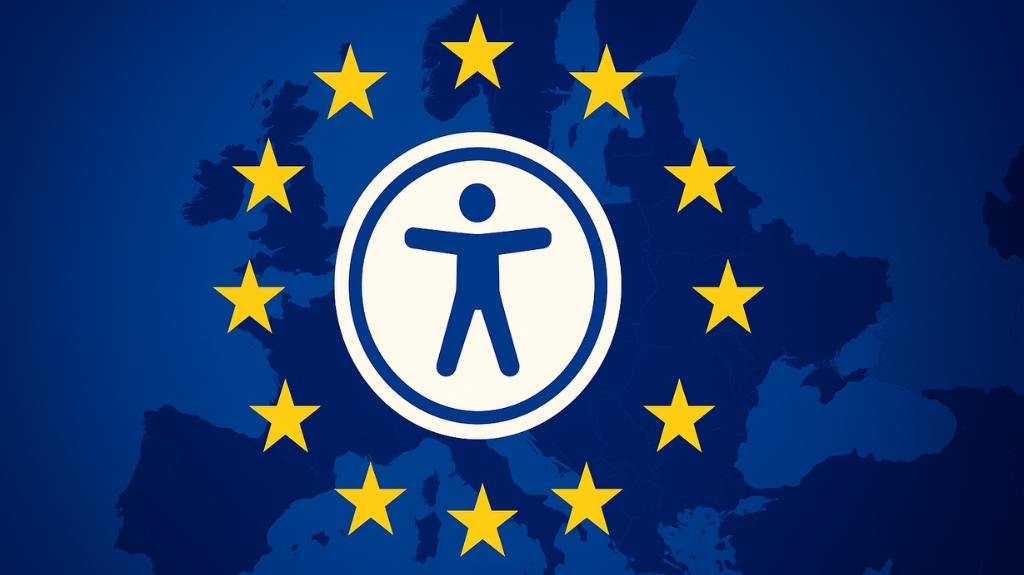
Europe’s Accessibility Act Kicks In: What You Need to Know for 2025

Table of Contents
Europe is about to take a big step toward greater accessibility. On June 28, 2025, the European Accessibility Act (EAA) finally takes effect across the EU. This new law is a broad effort to make everyday products and services more accessible to everyone – it could benefit over 87 million people with disabilities in Europe. Think of it as Europe leveling the playing field so that disability isn’t a barrier to using modern technology, websites, or services.
The EAA is built on the idea of “universal design” – making things usable by as many people as possible without special adaptation. In other words, instead of creating separate versions for people with disabilities, the aim is to design products and services that work for everyone from the start. This approach not only ensures equal access for people with disabilities but also often creates a better user experience for all. And by setting consistent standards across EU countries, the Act will remove many of the barriers caused by different accessibility rules in each nation.
What Is the European Accessibility Act?
In a nutshell, the European Accessibility Act is a new EU-wide law that mandates accessibility for a wide range of products and services. It was approved back in 2019, and EU member countries were given time to translate it into national laws. Now, as of June 28, 2025, those laws come into force. Practically, this means any company (no matter where it’s based) that wants to sell products or offer services in the EU must comply with these accessibility requirements. The goal is to make sure people with disabilities have the same access to products and services as everyone else, whether it’s using a smartphone, withdrawing money from an ATM, or shopping online.
What Does the EAA Cover?
The Act mandates accessibility for a surprisingly broad array of everyday products and services. Here’s an overview of what needs to be made accessible under the EAA:
- Consumer electronics – computers, smartphones, tablets, TVs, gaming consoles, and similar devices
- Websites and mobile apps – including online services like e-commerce sites, booking platforms, and other digital content
- Self-service kiosks – for example, ATMs, ticketing machines, vending machines, and airport check-in terminals
- Passenger transport services and info – from air, rail, bus, to ferry travel, including real-time travel information and e-ticketing systems
- Banking services – such as banking websites, payment terminals, and online banking apps
- E-books and e-readers – digital books and the devices/software used to read them
- Audio-visual media services – for instance, digital TV broadcasts, streaming services, and related consumer equipment
And that’s not an exhaustive list – there are “and more” in the fine print. Essentially, the EAA focuses on the products and services that matter most to people with disabilities (and that used to have different rules in each country). If it’s something you use regularly – your phone, your computer, a ticket machine, a website – the idea is that it shouldn’t shut out users with disabilities.
Who Benefits from the EAA?
The obvious winners are people with disabilities living in or traveling to Europe. We’re talking about a huge population – roughly one in five Europeans has some form of disability (around 87 million people). For these individuals, the EAA promises more inclusive access to technology and services. Booking a train ticket, using a banking app, or reading an e-book should become easier experiences that don’t require workaround hacks or special assistance.
Importantly, the Act’s benefits will extend beyond just those 87 million. Accessibility improvements tend to help everyone in some way. For example, clearer web page layouts and captions on videos are useful to all users, not only those with disabilities. An older traveler with fading eyesight or a parent pushing a stroller can appreciate a well-designed ramp or an easy-to-use ticket machine just as much as a wheelchair user. By pushing universal design, the EAA is likely to make everyday tech and services more user-friendly for the general public, too.
Even tourists visiting Europe stand to gain. If you’re a traveler with a disability, a more accessible Europe means less hassle. Imagine planning a trip and knowing that the train stations will have tactile guidance and the ticket kiosks can talk to you or have an easy touchscreen mode. The EAA will improve travel tools: digital travel apps will be more accessible, ticket machines will be easier to use (e.g., providing audio instructions for blind users), and transport info will be available in formats everyone can access. In short, moving around and enjoying what Europe offers should get a bit smoother for anyone with access needs, whether they live in Paris or are just visiting for the weekend.
Impact on Businesses and Innovation
So what does this mean for businesses? In simple terms, companies have to comply, or they risk penalties. Starting in June 2025, any business selling a product or service covered by the EAA in the EU market must meet these accessibility standards. If they don’t, they could face enforcement actions – typically fines or other penalties – determined by each EU country’s laws (the EU requires the penalties to be “effective, proportionate, and dissuasive,” so they won’t be just a slap on the wrist). In extreme cases, a company that refuses to comply might even be barred from selling that product or service in the EU. In other words, accessibility isn’t optional anymore; it’s a legal requirement.
There’s a silver lining for businesses, though. Harmonizing the rules across all EU countries actually makes life easier for companies in the long run. Before, a tech company might have had to deal with different accessibility regulations in Germany, France, Spain, etc. – a real headache. The EAA replaces this patchwork with one common set of standards, which can reduce costs and complexity. It also opens up the market: if you make an accessible product, you can sell it more easily throughout the whole EU without worrying about varying national rules. This unified approach can even boost innovation. How so? Well, when you know the entire European market (hundreds of millions of consumers) is open to an accessible product, there’s a bigger incentive to invest in new accessible tech and services. Businesses can find new opportunities by catering to the huge demographic of people who benefit from accessible design. In short, the Act isn’t just a compliance burden – it’s also pushing companies to be more creative and inclusive, which can expand their customer base.
Are There Any Exceptions or Challenges?
Now, you might be wondering: Does every business have to follow these rules? The law does recognize that a one-size-fits-all approach could be tough for some. There are a couple of important exceptions:
- Micro-enterprises: Really small businesses get a bit of a break. If a company has fewer than 10 employees and under €2 million in annual turnover, it’s generally exempt from the EAA requirements. The idea is that a tiny mom-and-pop shop or startup shouldn’t be crushed by accessibility obligations if they don’t have the resources. (Some countries might still encourage them to comply, but the EU law doesn’t force the smallest players.)
- “Fundamental alteration” or “disproportionate burden”: These phrases sound technical, but they’re basically escape clauses for cases where making something fully accessible is nearly impossible or unreasonably costly. If complying with the EAA would fundamentally change the nature of a product/service, or if the costs are wildly disproportionate to the benefit, a company might not be required to do that specific thing. For example, if adding a certain feature would ruin the core function of a device, or if a small manufacturer finds the cost of redesigning a product absolutely ruinous, the authorities can decide that it’s not feasible to enforce that part. However, these exceptions are not carte blanche – companies have to justify them. They’re expected to meet the requirements up to the point where it truly becomes an undue burden.
Even with these exemptions, the overall impact of the EAA will be widespread. The vast majority of medium and large businesses, and any consumer-facing tech or service, will fall under these rules. Some sectors have been improving accessibility voluntarily for years, so they’re ahead of the game. Others might scramble a bit to catch up. We might also see some companies initially worried about costs, but then realizing that accessible design often improves their product for all users (for instance, good color contrast on a website helps everyone in bright sunlight, not just users with low vision).
It’s also worth noting that while the EAA is a big leap forward, it won’t solve every accessibility issue overnight. For one, it mainly targets certain products and digital services – it’s not a blanket law that suddenly makes all buildings step-free or forces every cafe to have braille menus. So you’ll still encounter, say, a small family-owned restaurant in a historic building that has a staircase and no ramp. Very small shops or venues might not be covered by the law at all if they qualify as micro-enterprises. In practice, this means tourists and locals with disabilities may still face barriers in some places, especially outside of the domains the EAA covers. Some businesses and public spaces in Europe are already very accessible, while others may never be due to practical limitations or exemptions.
Toward a More Accessible Europe
All told, the European Accessibility Act is a landmark moment for inclusion. It represents a commitment that accessibility is a right, not a privilege. By setting common rules, the EAA is poised to gradually raise the baseline of accessibility across all EU countries. Starting in 2025, we’ll likely see a wave of improvements: more accessible websites, kiosks that everyone can use, apps that consider users of all abilities, and so on. Enforcement will take time and we might not notice changes immediately on day one. But piece by piece, these requirements can transform the user experience for millions.
Perhaps most exciting, 2025 could mark the beginning of a truly more accessible Europe, not just for Europeans with disabilities, but for anyone who benefits from accessible design. A traveler with a wheelchair from abroad might find it easier to navigate European cities using standardized accessible apps and ticket machines. An elderly local could discover that shopping online has become less frustrating. The hope is that as the EAA rolls out, accessibility stops being a niche concern and becomes just a normal part of how products and services are built. Like a friend might tell you over coffee, this is Europe opening its doors wider, making sure more people can come in. The journey isn’t complete in 2025, but it’s a confident step toward a more inclusive future. And that’s something worth cheering about as we watch Europe change for the better.
Sources: The facts and figures in this article are backed by the European Commission and accessibility experts, including official EU announcements and analyses of the EAA, among others. These ensure that the information is accurate and up-to-date as Europe ushers in this new era of accessibility in 2025.
TWIA
Although all hotel and vacation rental information on this site is thoroughly vetted, we recommend calling ahead to ensure your needs are met.
Newsletter Sign Up:
Thank you!
You have successfully joined our subscriber list.